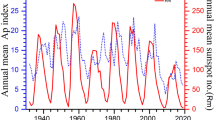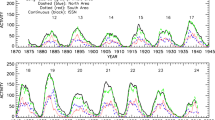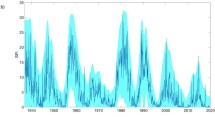Abstract
A “Solar Dynamo” (SODA) Index prediction of the amplitude of Solar Cycle 25 is described. The SODA Index combines values of the solar polar magnetic field and the solar spectral irradiance at 10.7 cm to create a precursor of future solar activity. The result is an envelope of solar activity that minimizes the 11-year period of the sunspot cycle. We show that the variation in time of the SODA Index is similar to several wavelet transforms of the solar spectral irradiance at 10.7 cm. Polar field predictions for Solar Cycles 21 – 24 are used to show the success of the polar field precursor in previous sunspot cycles. Using the present value of the SODA index, we estimate that the next cycle’s smoothed peak activity will be about \(140 \pm30\) solar flux units for the 10.7 cm radio flux and a Version 2 sunspot number of \(135 \pm25\). This suggests that Solar Cycle 25 will be comparable to Solar Cycle 24. The estimated peak is expected to occur near \(2025.2 \pm1.5\) year. Because the current approach uses data prior to solar minimum, these estimates may improve as the upcoming solar minimum draws closer.




Similar content being viewed by others
References
Babcock, H.W.: 1961, The topology of the Sun’s magnetic field and the 22-year cycle. Astrophys. J. 133, 572. DOI . ADS .
Brown, G.: 1986, Working group “A” report: long-term solar activity predictions. In: Simon, P.A., Heckman, G., Shea, M.A. (eds.) Solar-Terrestrial Predictions, 1. ADS .
Brown, G.M., Williams, W.R.: 1969, Some properties of the day-to-day variability of Sq(H). Planet. Space Sci. 17, 455. DOI . ADS .
Charbonneau, P.: 2010, Dynamo models of the solar cycle. Living Rev. Solar Phys. 7(3). DOI .
Clette, F., Svalgaard, L., Vaquero, J.M., Cliver, E.W.: 2014, Revisiting the sunspot number. Space Sci. Rev. 186(1–4), 35. DOI .
Feynman, J.: 1982, Geomagnetic and solar wind cycles, 1900–1975. J. Geophys. Res. 87, 6153.
Hathaway, D.H.: 2010, The solar cycle. Living Rev. Solar Phys. 7(1). DOI .
Hathaway, D.H., Wilson, R.M., Reichman, E.J.: 1994, The shape of the sunspot cycle. Solar Phys. 151, 177. DOI .
Hathaway, D.H., Wilson, R.M., Reichman, E.J.: 1999, A synthesis of solar cycle prediction techniques. J. Geophys. Res. 104, 375. DOI .
Hoeksema, J.T.: 2010, Evolution of the large-scale magnetic field over three solar cycles. In: Kosovichev, A.G., Andrei, A.H., Rozelot, J.-P. (eds.) Solar and Stellar Variability: Impact on Earth and Planets, IAU Symposium 264, 222. DOI . ADS .
Howard, R.: 1977, Large-scale solar magnetic fields. Annu. Rev. Astron. Astrophys. 15, 153. DOI . ADS .
Leighton, R.B.: 1969, A magneto-kinematic model of the solar cycle. Astrophys. J. 156, 1. DOI . ADS .
Li, K.J., Yun, H.S., Gu, X.M.: 2001, On long-term predictions of the maximum sunspot numbers of solar cycles 21 to 23. Astron. Astrophys. 368, 285. DOI .
McNish, A.G., Lincoln, J.V.: 1949, Prediction of sunspot numbers. Eos Trans. AGU 30, 673. DOI . ADS .
Muñoz-Jaramillo, A., Nandy, D., Martens, P.C.H.: 2009, Helioseismic data inclusion in solar dynamo models. Astrophys. J. 698, 461. DOI . ADS .
Muñoz-Jaramillo, A., Sheeley, N.R., Zhang, J., DeLuca, E.E.: 2012, Calibrating 100 years of polar faculae measurements: implications for the evolution of the heliospheric magnetic field. Astrophys. J. 753, 146. DOI . ADS .
Ohl, A.I., Ohl, G.I.: 1979, A new method of very long-term prediction of solar activity. In: Donnelly, R. (ed.) Solar-Terrestrial Predictions Proceedings 2, 258. NOAA/Space Environment Laboratory. ADS .
Parker, E.N.: 1977, The origin of solar activity. Annu. Rev. Astron. Astrophys. 15, 45. DOI . ADS .
Pesnell, W.D.: 2008, Predictions of Solar Cycle 24. Solar Phys. 252, 209. DOI . ADS .
Pesnell, W.D.: 2014, Predicting Solar Cycle 24 using a geomagnetic precursor pair. Solar Phys. 289, 2317. DOI . ADS .
Pesnell, W.D.: 2016, Predictions of Solar Cycle 24: how are we doing? Space Weather 14, 10. DOI . ADS .
Priyal, M., Banerjee, D., Karak, B.B., Muñoz-Jaramillo, A., Ravindra, B., Choudhuri, A.R., Singh, J.: 2014, Polar network index as a magnetic proxy for the solar cycle studies. Astrophys. J. Lett. 793(1), L4. DOI .
Schatten, K.H.: 1990, A solar cycle timing predictor—the latitude of active regions. Solar Phys. 125, 185. DOI . ADS .
Schatten, K.H.: 2005, Fair space weather for solar cycle 24. Geophys. Res. Lett. 32, L21106. DOI .
Schatten, K.H., Myers, D.J., Sofia, S.: 1996, Solar activity forecast for Solar Cycle 23. Geophys. Res. Lett. 23, 605. DOI . ADS .
Schatten, K.H., Pesnell, W.D.: 1993, An early solar dynamo prediction: cycle 23 ∼ cycle 22. Geophys. Res. Lett. 20, 2275. DOI . ADS .
Schatten, K.H., Sofia, S.: 1987, Forecast of an exceptionally large even-numbered solar cycle. Geophys. Res. Lett. 14, 632. DOI . ADS .
Schatten, K.H., Scherrer, P.H., Svalgaard, L., Wilcox, J.M.: 1978, Using Dynamo Theory to predict the sunspot number during Solar Cycle 21. Geophys. Res. Lett. 5, 411. DOI .
Sheeley, N.R., Wang, Y.-M., Harvey, J.W.: 1989, The effect of newly erupting flux on the polar coronal holes. Solar Phys. 119, 323.
Suggs, R.J.: 2013, Future solar activity estimates for use in prediction of space environmental effects on spacecraft orbital lifetime and performance. Technical Report, NASA, Marshall Space Flight Center. File dated June 2013. http://sail.msfc.nasa.gov/current_solar_report/CurRpt.pdf .
Svalgaard, L., Cliver, E.W., Kamide, Y.: 2005, Sunspot Cycle 24: smallest cycle in 100 years? Geophys. Res. Lett. 32, 1104. DOI . ADS .
Tapping, K.F.: 2013, The 10.7 cm solar radio flux (F10.7). Space Weather 11, 394. DOI . ADS .
Waldmeier, M.: 1939, Über die Struktur der Sonnenflecken. Astron. Mitt. Eidgenöss. Sternwarte Zür. 14, 439. ADS .
Waldmeier, M.: 1955, Ergebnisse und Probleme der Sonnenforschung, 2. erweiterte aufl. edn. Geest & Portig, Leipzig. ADS .
Zhao, J., Kosovichev, A.G., Bogart, R.S.: 2014, Solar meridional flow in the shallow interior during the rising phase of Cycle 24. Astrophys. J. Lett. 789, L7. DOI . ADS .
Zhao, J., Bogart, R.S., Kosovichev, A.G., Duvall, T.L. Jr., Hartlep, T.: 2013, Detection of equatorward meridional flow and evidence of double-cell meridional circulation inside the Sun. Astrophys. J. Lett. 774, L29. DOI . ADS .
Acknowledgements
This work was supported by NASA’s Solar Dynamics Observatory. F10.7 values are courtesy of the Dominion Radio Astronomy Observatory. Adjusted F10.7 (normalized to 1 AU) were downloaded from the National Geophysical Data Center (NGDC, https://www.ngdc.noaa.gov/stp/space-weather/solar-data/solar-features/solar-radio/noontime-flux/penticton/penticton_adjusted/listings/listing_drao_noontime-flux-adjusted_daily.txt ). The polar magnetic field data are from the Wilcox Solar Observatory ( http://wso.stanford.edu/Polar.html ) and are courtesy of J. T. Hoeksema. The Wilcox Solar Observatory is currently supported by NASA. International Sunspot Numbers were obtained from the Solar Influences Data Center (SIDC) website, http://www.sidc.be/silso/DATA/dayssnv0.dat for \(R_{Z}^{V_{1}}\) and http://www.sidc.be/silso/DATA/SN_d_tot_V2.0.txt for \(R_{Z}^{V_{2}}\).
Author information
Authors and Affiliations
Corresponding author
Ethics declarations
Disclosure of Potential Conflicts of Interest
The authors declare that they have no conflicts of interest.
Rights and permissions
About this article
Cite this article
Pesnell, W.D., Schatten, K.H. An Early Prediction of the Amplitude of Solar Cycle 25. Sol Phys 293, 112 (2018). https://doi.org/10.1007/s11207-018-1330-5
Received:
Accepted:
Published:
DOI: https://doi.org/10.1007/s11207-018-1330-5




